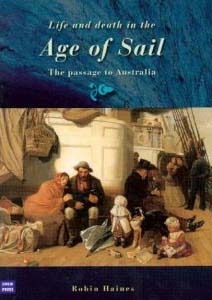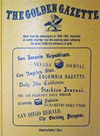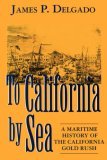Passengers at the Port of San Francisco: 1800s

Barque Gloucester
Arrive San Francisco
Departed Sydney, Australia, for San Francisco December 23, 1849
Arrived San Francisco: May 28, 1850
Placer Times
Marine Journal
Barque Gloucester, Tardiff, 152 ds fm Sydney, via Auckland, 116 ds, 158 pass, 35 females
Master: Tardiff
152 days from Sydney, Australia via Auckland, 116 ds, 158 pass, 35 females.
Passage
1849 July 1st: The barque arrived in Sydney from Sourabaya (departed from Sourabaya 1849 April 25th)
1849 Dec 20th cleared Sydney
1849 Dec 23rd background Passengers not listed in departure record tsg:302
1849 Dec 25th arrival Sydney tsg:302
1849 Dec 28th departure Sydney tsg:302
1849 Dec 28th background Resumed voyage tsg:302
1850 January 10th, arrived Auckland, New Zealand
May 23, 1850: Daily Alta California, San Francisco, California
Shipping Intelligence. Port of San Francisco.
SPOKEN. By Eliza, 15th May, lat 33 40 north, long. 132 44 west, barque Gloucester, for Sydney for this port, which was reported having spoken, two days previous, schooner Esther, from Sydney, do.
May 31, 1850, Placer Times, Placerville, California
Marine Journal: Br. bark Gloucester, Tardiff, 152 days from Sydney via Auckland, 116 days, 158 passengers, 35 females.
Cargo
June 11, 1850, Daily Alta California, San Francisco, California
BARK GLOUCESTER - Shippers and consignees by this vessel are informed, that if their goods are not removed within fifteen days from the date of arrival, demurrage will commence. Parties not having paid the balance of their freight, are informed that if it is not paid immediately their goods will be sold at the expiration of the above 15 days.
~ ~ ~ ~
August 13, 1850, Daily Alta California, San Francisco
LOCAL MATTERS
SUPERIOR COURT . . . Most of the day was occuped in arguments on the suit of Mackay & Co., vs. barque Gloucester. The subject was taken under advisement by the Court.
~ ~ ~ ~
August 31, 1850, Daily Alta California, San Francisco
LOCAL MATTERS
In the suit of Charles G. Noble vs. bark Gloucester, judgment by default was rendered in favor of plaintiff.
~ ~ ~ ~
September 14, 1850, Daily Alta California, San Francisco
LAW COURTS
SUPERIOR COURT.--The Court made an order yesterday that the sheriff show cause on the 14th inst. why he should not be made to levy on the bark Gloucester, in the suit of Elias J. Scobie against said barque.
~ ~ ~ ~
November 21, 1850, Daily Alta California, San Francisco
During the gale of Tuesday night, the British bark Gloucester, a storeship belonging to Starkey Brothers, careened over with the force of the wind, filled, and sunk; she had a large number of ironhouses on board.
Passengers

Nagle, Capt.
Cook, Dr.
English, Lawrence
Craddock, John
Vinson, Edward and wife
Farrington, William and wife
Padmore, Alfred
Knowlton, James
Richards, Frederick
Martin, William V and wife, 2 daughters
McDermott, John
Maddox, Joseph
Higgs, Charles
McGregor, John
Pudney, William
Bowden, Thomas
Sutton, Robert and wife
Brierley, James
Butler, Patrick
Rigley, James and wife
Corbett, James W.
Swain, Thomas
Evans, Maurice
Brierley, Ittai
Lane, Henry
Jessop, William
Comerford, Patrick
Comerford, James
McDonald, Francis and wife, 3 sons
Gambold, John David and wife
McGovern, James
Coleman, Mrs.
Spax, Harriet
Dean, Samuel
Conners, John
Smith, William and wife, son
Marr, Robert Henry and wife, son, 3 daughters
Marr, Alexander
Harper, Alexander
Doherty, Michael
Smith, Joseph and wife
Smith, Joseph
West, Spencer
Drake, Henry
Norton, Patrick
Carroll, John and wife, 3 sons
Steel, Andrew
Craig, William
Brown, Charles and wife, son, 2 daughters
Flood, Martin
Chapman, John
McVee, Peter
McKinnon, Henry
Latimer, George
Newson, Cornelius
Robinson, Mrs and son, daughter
Moore, Mrs
O'Brien, Margaret
McGrath, James
Drinkwater, Thomas and wife, 2 daughters
Andrews, George and wife
Benson, John
Wicks, Robert
Hughes, David
Casey, Michael
Couley, Peter
Little, George
Weir, James and wife, daughter
McLaren, Malcolm
Macarthur, John
Aiken, John
Sullivan, Arthur
Curby, Mrs
Gluzas, William
O'Donnell, Daniel and wife, son
Davidson, Martha
Out on the Deep Blue: True Stories of Daring, Persistence, and Survival from the Nation's Most Dangerous Profession
Leslie Leyland Fields, Editor.
The first collection of first-person accounts of commercial fishing written by the men and women who work in the nation's most dangerous occupation. Nineteen diverse fisher-writers, from the famous to the unknown, take the reader swordfish harpooning on the Georges Banks, winter crabbing in the Bering Sea, sea-urchin diving off Maine, herring fishing in Alaska, shark-harpooning off Scotland and points between. Fine writing on commercial fishing, blending the voices of such well-known writers as Peter Mathiessen, Gavin Maxwell, Linda Greenlaw, Spike Walker, and John Cole, together with experienced and emerging writers, many of whom have spent much of their lives on the water.
The Mammoth Book of Life Before the Mast:
Sailors' Eyewitness Stories from the Age of Fighting Ships
Jon E. Lewis, Editor
Firsthand accounts of the real-life naval adventures behind the popular historical sagas of Patrick O'Brian and C. F. Forester. Twenty true-life adventures capture the glory and gore of the great age of naval warfare from the late eighteenth to the early nineteenth century -- the age of the French Revolutionary War, the Napoleonic Wars, and the War of 1812 -- when combat at sea was won by sheer human wit, courage, and endurance. Culled from memoirs, diaries, and letters of celebrated officers as well as sailors, the collection includes accounts of such decisive naval engagements as Admiral Horatio Nelson's on the Battle of the Nile in 1798 or Midshipman Roberts' on the Battle of Trafalgar in 1805 and also offers glimpses into daily hardships aboard a man-of-war: scurvy, whippings, storms, piracy, press gangs, drudgery, boredom, and cannibalism.
Sweatshops at Sea: Merchant Seamen in the World's First Globalized Industry, from 1812 to the Present

Leon Fink
As the main artery of international commerce, merchant shipping was the world's first globalized industry, often serving as a vanguard for issues touching on labor recruiting, the employment relationship, and regulatory enforcement that crossed national borders. Historian Leon Fink examines the evolution of laws and labor relations governing ordinary seamen over the past two centuries.
The merchant marine offers an ideal setting for examining the changing regulatory regimes applied to workers by the United States, Great Britain, and, ultimately, an organized world community. Fink explores both how political and economic ends are reflected in maritime labor regulations and how agents of reform--including governments, trade unions, and global standard-setting authorities--grappled with the problems of applying land-based, national principles and regulations of labor discipline and management to the sea-going labor force. With the rise of powerful nation-states in a global marketplace in the nineteenth century, recruitment and regulation of a mercantile labor force emerged as a high priority and as a vexing problem for Western powers. The history of exploitation, reform, and the evolving international governance of sea labor offers a compelling precedent in an age of more universal globalization of production and services.
Life of a Sailor (Seafarers' Voices)
Frederick Chamier
Chamier went to sea in 1809 as an officer in the Royal Navy. Like his contemporary, Captain Frederick Marryat, he enjoyed a successful literary career and is remembered for his naval novels. This book, his first, is usually catalogued as fiction, although it is an exact account of his naval experiences, with every individual, ship, and event he described corroborated by his service records. Told with humor and insight, it is considered an authentic account of a young officer's service. From anti-slavery patrols off Africa to punitive raids on the American coast during the War of 1812, Chamier provides details of many lesser-known campaigns. His descriptions of British naval operations in America, which reflected his objection to bringing the war to the civilian population, were highly criticized by his seniors.
The Nagle Journal: A Diary of the Life of Jacob Nagle, Sailor, from the Year 1775 to 1841
John C. Dann
Great Stories of the Sea & Ships
N. C. Wyeth
More than 50,000 copies of this collection of high-seas adventures are in print. It showcases the fiction of such classic writers as Daniel Defoe, Jules Verne, and Jack London, and the entries also feature historic first-person narratives including Christopher Columbus’s own account of his voyage in 1492. Vivid tales of heroic naval battles and dangerous journeys of exploration to the stories of castaways and smugglers. The variety of works includes “The Raft of Odysseus,” by Homer; Hans Christian Andersen’s “The Mermaid”; “The Specksioneer,” by Elizabeth Gaskell; Washington Irving’s “The Phantom Island”; and “Rounding Cape Horn,” by Herman Melville. Eighteen extraordinary black and white illustrations by Peter Hurd add to the volume's beauty.
The Rebel Raiders
The Astonishing History of the Confederacy's Secret Navy
James T. deKay
This true story of the Anglo-Confederate alliance that led to the creation of a Southern navy illuminates the dramatic and crucial global impact of the American Civil War. Like most things in the War between the States, it started over cotton: Lincoln’s naval blockade prevented the South from exporting their prize commodity to England. In response, the Confederacy came up with a plan to divert the North’s vessels and open the waterways–a plan that would mean covertly building a navy in Britain, a strategy that involved a cast of clandestine characters.















 Copyright ~ 1998-2018.
Copyright ~ 1998-2018. 